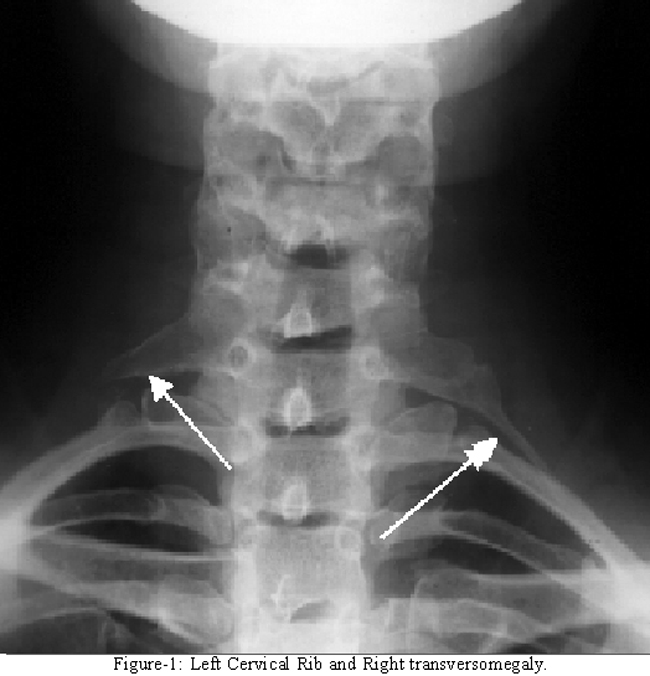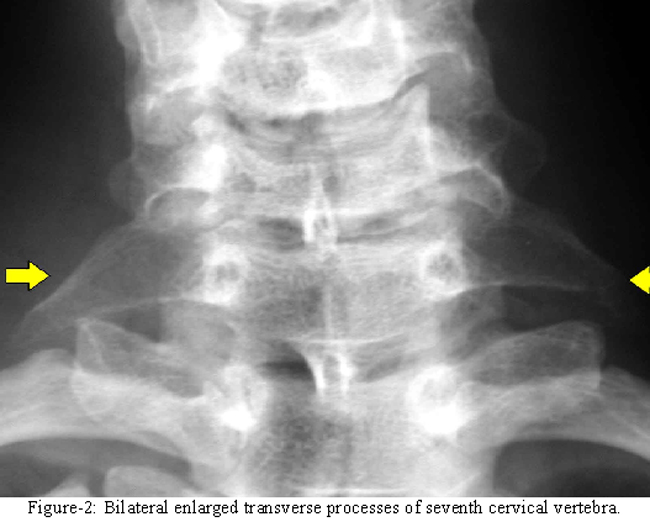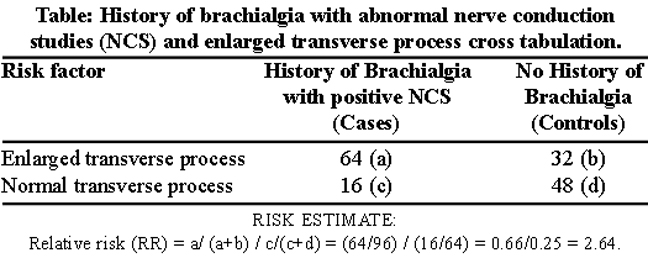Sadia Raheez Qamar ( Department of Radiology Military Hospital, Rawalpindi. )
Muhammad Hamid Akram ( Department of Radiology Military Hospital, Rawalpindi. )
Pervez Hassan Khan Niazi ( Department of Radiology, AFIRM, Rawalpindi. )
May 2011, Volume 61, Issue 5
Original Article
Abstract
Objectives: To determine the association between length of transverse process of seventh cervical vertebrae on plain x-ray cervical spine AP-view and nerve conduction studies of respective patients having brachialgia.
Methods: The study was carried out at Department of Radiology, Military Hospital Rawalpindi in collaboration with Armed Forces Institute of Rehabilitation Medicine (AFIRM) Rawalpindi from January 2004 to December 2004. A total of 160 adult subjects were enrolled in this study including 80 volunteers with no history of brachialgia. Eighty subjects suffered from brachialgia and were documented to have abnormal nerve conduction studies/Electromyography referred from AFIRM Rawalpindi. X-ray cervical spine AP-view of all patients was taken. Relative risk (RR) was calculated to determine the association.
Results: Eighty percent (64 out of 80) patients with brachialgia and documented abnormal nerve conduction studies had prominent transverse process of seventh cervical vertebrae on x-ray cervical spine AP-view. RR for developing brachialgia was 2.64 and association was statistically significant.
Conclusion: X-ray cervical spine AP-view is a simple, quick and tolerable method of measuring transverse process of seventh cervical vertebra. This can predict which individuals are more likely to develop brachialgia.
Keywords: Seventh cervical spine, Brachialgia, Nerve conduction studies (JPMA 61:429; 2011).
Introduction
Brachialgia is defined as "Pain in the arm."1 Pain is hallmark of acute or chronic nerve root compression. Pain due to nerve root compression has certain characteristics: firstly, it tends to follow a dermatomal distribution; secondly it may be accompanied by paresthesia and thirdly it may be associated with loss of power in the muscles innervated by the root.2
Pain in the arm and symptoms caused by cervical spine (neck) disorders are a very common problem for many adults. Neck is composed of many different anatomic structures, including muscles, bones, ligaments, nerves and joints.3 There are seven cervical vertebrae (C1- C7) in the vertebral column. The transverse processes of C7 are directed downward and outward, and are bifid at their extremity. These are usually of large size. Occasionally the transverse process exists as a separate bone, and attains a large size (Figure-1).
It is then known as "cervical rib."4 One of the major causes of brachialgia at C8 and T1 nerve roots level is "enlarged seventh cervical transverse process" (Figure-2).5
Plain x-rays are still widely used in most units of radiology worldwide.6 Besides other anatomical landmarks; enlarged seventh cervical transverse process can be easily visualized by an antero-posterior view of the cervical spine. In addition to radiological examination, electro-diagnosis substantially alters the clinical impressions in a large percentage of patients with brachialgia.7,8
Electro diagnosis or nerve conduction studies/clinical electromyography (NCS/EMG) is the electrophysiological study of nerve and muscle, which is used to diagnose nerve damage or destruction.9-11 It is basically a test of speed of conduction of impulses through an electrically stimulated nerve, usually with surface electrodes, placed on the skin over the nerve at various locations.12 The results include tabulated nerve conduction studies (NCS) and needle EMG findings.13-15
The aim of this study was to measure the length of the transverse process of seventh cervical vertebrae on plain x-ray cervical spine AP-view and compare it with results of nerve conduction studies/Electromyography in patients having brachialgia.
Patients and Methods
This prospective case-controlled study was carried out on 160 adult subjects from January 2004 to December 2004. Patients were divided into two groups. In Group 1 (Controls), 80 subjects with no neurological symptoms were randomly included from those patients coming to Radiology Department, Military Hospital Rawalpindi for X-ray examination of regions other than cervical spine. Patients with trauma to cervical spine, inflammatory and degenerative conditions were excluded. In Group 2 (study group), 80 patients with symptoms of brachialgia were included. These were those patients who presented in AFIRM, Rawalpindi for their nerve conduction studies. NCS were performed on peripheral nerves of upper limbs including Ulnar and Median nerves bilaterally. These nerves were examined across neck, arm, elbow and forearm using surface electrodes. Values of peripheral nerve conduction velocities, amplitude and latencies were obtained. Motor and sensory velocities in symptomatic limbs were compared with other limb keeping 50 m/sec as normal velocity of Median nerve and 65 m/sec in Ulnar nerve. Normal value for distal motor latency was 3.7 ms. EMG studies were done using concentric needle electrodes. Cervical paraspinal and 1st Dorsal Interossei muscles were sampled. Sampled muscles were evaluated for neuropathic patterns. These patients with abnormal nerve conduction studies and documented proof of neurogenic thoracic outlet syndrome were referred to our department. Informed consent was obtained from all subjects included in the study. X-ray cervical spine-AP views of both groups were taken with same x-ray machine considering standard recommended position of patient. Film focus distance was kept 72 inches in every patient. Spinous process of cervical spine was taken as midpoint and the lengths of both the transverse processes of cervical vertebrae were measured separately.
Prominent transverse process rating scale was made in which, prominent transverse process was taken as a transverse process measuring > 4.5 cm on x-ray cervical spine AP view. Rating was done for both the transverse processes separately. Keeping the nerve conduction studies as gold standard, results were compared between two groups.
Data was expressed in frequencies or mean (standard deviation) unless stated otherwise. RR was calculated to determine the relative risk of an individual with enlarged transverse process for developing brachialgia as compared to those subjects whose transverse process was not enlarged. Chi-square test (c2 test) was used to compare different proportions among study and control subjects. p-value of < 0.05 was considered significant.
Results
The patients included in this study had mean age of 41.58±11.69 years in group 1 and 39.69±12.12 years in group 2.
In Group 1 (Controls), size range of transverse processes was 3.2 to 4.9 cm on right side, and 3.1 to 5.2 cm on left side. In Group 2 (Cases), it was 3.7 to 6.0 cm on right side and 4.0 to 6.5 cm on left side. Taking 4.5 cm as cutoff point for prominent transverse processes, in Group1, 46.25% (32 out of 80) subjects had either prominent right or left transverse processes. In Group 2, 80% (64 out of 80) patients had prominent transverse process of one side or other.
The relative risk for length of transverse process indicating risk of development of brachialgia was calculated as 2.64 which means that a person with enlarged transverse process of seventh cervical vertebra is 2.64 times more likely to develop brachialgia compared with a person whose transverse process is not enlarged (Table).
The association between brachialgia and enlarged transverse process of seventh cervical vertebra, was statistically significant (p < 0.01).
Results of nerve conduction studies (NCS) were compared with findings on x-ray cervical spine of patients in Group 2. Patients having symptoms in one limb with abnormal NCS had increase in size of ipsilateral transverse process of seventh cervical vertebrae on plain x-ray cervical spine AP view. Fifty percent (40 out of 80) patients had increased size of left transverse process on x-ray cervical spine. Decreased motor and sensory velocities in left Ulnar and Median nerves were appreciated in 84.3% (33 out of 40) patients. Increased distal motor latency was observed in all these patients. Similarly 30% (24 out of 80) patients in Group 2 had increased size of right transverse process on x-ray cervical spine with 94.7 % (22 out of 24) of those having decreased conduction velocities and altered latencies in right sided Ulnar and Median nerves. Polyphasic giant potentials and discrete patterns suggestive of neuropathic EMG findings were appreciated in sampled cervical paraspinal and 1st Dorsal Interossei muscles in 80% (64 out of 80) patients in Group 2.
Discussion
The results of this study show that a cervical rib or C7 transversomegaly is a strong predictor for diagnosis of brachialgia in the adequate clinical context. Thoracic outlet region has been studied by advanced radiological modalities comparing both the affected and the contra lateral sides but the cervical spine is still best studied by conventional standard X-ray examination.16,17
In the presented study, the role of x-ray cervical spine was evaluated for presence of enlarged transverse process as a predictive risk factor for developing brachialgia. It was found that an individual with enlarged transverse process of seventh cervical vertebra is 2.64 times more likely to develop brachialgia as compared to a person whose transverse process is not enlarged. Thus, association between enlarged transverse process of seventh cervical vertebra and brachialgia was significant. This was in accordance to a study by Matsumoto M et al18 which showed importance of radiological examination especially x-ray cervical spine in patients having brachialgia.
Like wise the patients having enlarged transverse processes in our study were also assessed for the side of the lesion; 84.7% had increased size of one or other transverse process on x-ray cervical spine and had abnormal nerve conduction studies in the same limb. Marcaud et al19 in a study conducted in France showed that in patients having brachialgia and suspected to have neurogenic thoracic outlet syndrome, plain radiography exhibited rudimentary bilateral cervical rib or an elongated ipsilateral C7 transverse process in 100% of the cases.
Similarly a case report from Spain, on 2 female patients with symptoms of brachialgia and positive nerve conduction studies, showed cervical ribs in one case and elongated transverse process of C7 in the other, on Xray cervical spine. This proved that association of enlarged C7 transverse process in patients having brachialgia is always significant.20
This finding can be of help in the long term employment of manual workers. The employers can get an increased productivity from workers and lower their expense on medical treatment and claims. It can also help suffering individuals in selecting a suitable job.
Conclusion
Prominent transverse process of seventh cervical vertebra has a definite relationship with brachialgia in high percentage of cases. X-ray cervical spine AP-view is a simple, quick and tolerable method of measuring transverse process of seventh cervical vertebra.
References
1.Dictionary definition of Brachialgia. [Homepage of Dictionary Barn, A medical dictionary]. (Online) 2002-2003 (Cited 2004 Dec 02]. Available from URL: http://www.dictionarybarn.com.
2.Clinical features. [Homepage of GPnotebook]. (Online) 2004 (Cited 2004 Dec 24). Available from URL: http://www.gpnotebook.co.uk/homepage.cfm.
3.Symptoms. [Homepage of Neck Reference.com]. (Online) 2003 July 11 last update. (Cited 2004 Nov 28). Available from URL: http://www.neckreference.com.
4.Gray H. Anatomy of the Human body, 20th ed. Vol.1. Philadelphia: Lea & Febiger, 1918.
5.Wysocki J, Bubrowski M, Reymond J, Kwiatkowski J. Anatomical variants of the cervical vertebrae and the first thoracic vertebra in man. Folia Morphol (Warsz) 2003; 62: 357-63.
6.Sutton, D. Textbook of Radiology and Imaging. 7th Ed. Vol.1. New York: Churchill Livingston; 2003; pp 58.
7.Haig AJ, Tzeng HM, LeBreck DB. The value of electro diagnostic consultation for patients with upper extremity nerve complaints: a prospective comparison with the history and physical examination. Arch Phys Med Rehabil 1999; 80: 1273-81.
8.Investigations. [Homepage of GPnotebook]. (Online) 2004 (Cited 2004 Dec 24). Available from URL: http://www.gpnotebook.co.uk/homepage.cfm.
9.Katirji B. The clinical electromyography examination. An overview. Neurol Clin 2002; 20: 291-303.
10. Le Forestier N, Mouton P, Maisonobe T, Fournier E, Moulonguet A, Willer JG, et al. True neurological thoracic outlet syndrome. Rev Neurol 2000; 156: 34-40.
11.Aetna Inc. Nerve conduction velocity studies. Clinical Policy Bulletin. American Medical Association 2007; No: 0502.
12. Azeem MA, Rakkah NIA, Mustafa MA, Ali A, Farroq N, Ilyas M. Evaluation of hyperpolarization potentials and nerve conduction parameters in axonal neuropathic patients. Pak J Physiol 2007; 3: 9.
13.Dale WA. Thoracic outlet compression syndrome. Critique in 1982. Arch Surg 1982; 117: 1437-45.
14.Roos DB. New concepts of thoracic outlet syndrome that explain etiology, symptoms, diagnosis and treatment. J Vasc Surg 1979; 13: 313-21.
15.Sanders RJ, Hammond SL. Management of cervical ribs and anomalous first ribs causing neurogenic thoracic outlet syndrome. J Vasc Surg 2002; 36: 51-6.
16.Remy-Jardin M, Doyen J, Remy J, Artand P, Fribourg M, Ounamel A. Functional anatomy of thoracic outlet : evaluation with spiral CT. Radiology 1997; 205: 843-51.
17.Richter HP. Removal of the 1st rib in thoracic outlet syndrome. Is it helpful? Is it safe? Nervenarzt 1996; 67: 1034-7.
18.Matsumoto M, Ishikawa M, Ishii K, Nishinzawa T, Maruiwa H, Nakamura M, et al. Usefulness of neurological examination for diagnosis of the affected level in patients with cervical compressive myelopathy: prospective comparative study with radiological evaluation. J Neurosurg Spine 2005; 2: 535-9.
19.Marcaud V, Metral S. [Electrophysiological diagnosis of neurogenic thoracic outlet syndrome]. J Mal Vasc 2000; 25: 175-80.
20.Cruz-Martinez A, Arpa J. Electrophysiological assessment in neurogenic thoracic outlet syndrome. Electromyogr Clin Neurophysiol 2001; 41: 253-6.
Journal of the Pakistan Medical Association has agreed to receive and publish manuscripts in accordance with the principles of the following committees:




